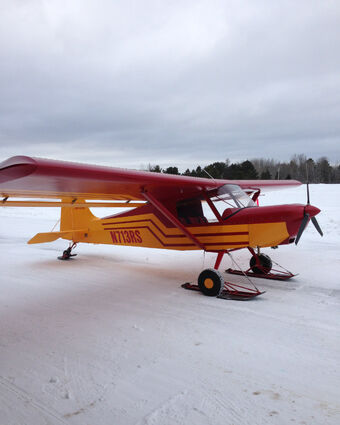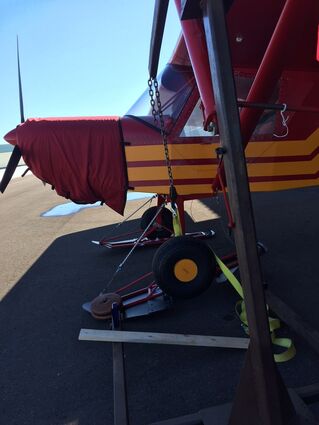Tales of another scary landing
February 24, 2023
As a youngster growing up in Superior and flying aircraft with my dad, I remember him saying, "If you want to wreck your airplane, put it on skis!"
He should know. I watched him and his World War II Army Air Corps buddies plan wolf hunts by skiplane like they were planning a mission to bomb the ball bearing plants in Schweinfurt, Germany. Safety was always a concern, since they were shooting shotguns out of the open door of the craft as they swooped down low on the wolves. (Bounty hunting of wolves by skiplane along the south shore of Lake Superior ended in the early 1960s.)
I earned my private pilot license in 1980 and built a Merlin GT in the 1990s, which I still fly out of the Cloquet airport. In March 2018 some of my Experimental Aircraft Association (EAA) friends were planning on flying to Ely, Minnesota for lunch and asked if I wanted to come along. Since it was shaping up to be a nice winter day, I quickly said yes. We all fly similar types of aircraft, which allows us to stay together on a trip, cruising about 85 to 90 mph.
On the day of the flight, we assembled at the airport and preheated our engines. The wind was out of the north northwest about 10 mph with a temperature of 10 degrees Fahrenheit, and the sky was clear. We all taxied out. Since I have wheel penetration skis - the wheels stick about a half-inch below the skis - I could use the runway while the others used the snow-packed side of the runway. I taxied and waited further down on the runway and took off after the last of the other three departed the snow.
Everything was normal as I monitored the instruments. My aircraft climbed rapidly after takeoff and I was soon at 2,800 feet, so I decided to stay there. I could see the three other aircraft in front of me at a lower altitude. As we passed navigational landmarks, I was settling into an enjoyable flight. However, I did start to notice the other aircraft seemed further north than mine but nothing was abnormal, and I thought maybe the north head wind might be stronger at my altitude.
The flight time to Ely was slightly over an hour and I did notice it may take me a little longer to arrive. Approaching the Laurentian Divide, I lost visual contact with the other three aircraft but, again, everything was normal by instrumentation in my craft. About 15 minutes south of Ely I flew past Babbitt and could see the Ely airport south of town, when suddenly the aircraft violently pitched down to my left.
What happened next takes only seconds, and although a pilot is trained for emergency conditions, they are all different when they arise. Quickly scanning the panel I noticed I was descending about 600 feet per minute at 90 mph, at 2,800 feet above the ground!
Since I could not right the craft, I immediately pulled the power to slow the descent and used stick and rudder pressure to keep it straight as the view through the windshield was snow-covered trees. I quickly looked at my left side ski and noticed it was extended to the safety cable - basically pointing part of the way down instead of being parallel to the plane - but the bungee cord was still attached. The drooping ski was the problem.
My dad would constantly point out possible landing sites as we flew and sometimes make a practice landing pass. Now it would be a real-life lesson for me. Knowing I could not make it to the Ely airport, I settled for Bear Island Lake, which was directly in front of me.
My concentration was on clearing the pine trees in the swamp and attempting to make a landing as slowly as possible without flipping the aircraft due to the hanging ski. I tightened my lap belt and shoulder harness and thought about landing on the right side ski. I cleared the tree tops by only a couple of feet and descended to the lake. Seeing a snowmobile track helped me understand how deep the snow may be when I land. My thoughts were racing between focusing on the best landing of my life and surviving the aircraft either flipping on its back or cartwheeling in the snow.
The aircraft was rapidly slowing down as it passed through 60 mph approaching the lake surface. I took one last look out the side window at the snow and the left ski hanging on its safety cable and anticipated the outcome, when suddenly, just before touching down, I heard a bang and then hit the snow. Luckily, just before landing the speed was slow enough that the memory left in the stretched bungee cord brought the ski up and the snow did the rest as the aircraft settled and landed.
I continued a high-speed taxi run toward the many snowmobile tracks between the mainland and Bear Island, knowing I could stop there without sinking in the deeper snow. Bringing the aircraft to a stop, I collected my thoughts, then called my fellow flyers to tell them what had happened. They were ready to get some snowmobile rubber bungees for me and fly them out, but prior to leaving the hangar I noticed three bungees on the workbench and threw them into the baggage compartment (who knows why).
After inspecting the aircraft and installing the bungees I had on both skis, I fired up the aircraft and took off toward downtown Ely, arriving safely. Needless to say I had a lot to talk about at lunch!
During the flight back I flew a little higher and slightly slower, straining to focus on the last leg of the flight rather than on the event that occurred. Every pilot mentally reviews over and over again any event that is out of the ordinary and running every possibility to ground.
Upon landing I wrote down my thoughts and continued to think through all the possible scenarios and causes. Since I followed Federal Aviation regulations AC43.13-2B during the design and installation of my skis, I decided to test the deflection force of the single bungee. The test definitely proved the original shock cord bungee could not handle the force when preloaded. Upon further investigation, I determined that the cord was not aircraft-quality even though it was purchased through a reputable aircraft supplier. During the investigation I also learned there is a cold-weather aircraft-quality shock cord available, and in cold weather it may be best to unhook your bungee cords when not flying, as they can retain load memory when the aircraft is sitting and may not be able to immediately pull the ski up to flight position after takeoff.
When ski-flying around Minnesota, it is not uncommon to fly low and slow over the many frozen lakes and rivers. The day of the flight I stated that my aircraft climbed to 2,800 feet and I flew it there. I believe this may have saved my life. Thinking back to that day, the craft violently pitched down very rapidly, and the extra altitude allowed me that split-second of time to respond and stretch my descent to keep me out of the trees. Also, when I was slowly dropping behind the other aircraft, I did not realize the bungee was stretching and allowing the ski to slowly drop down until the force on the wider ski overcame the bungee cord and dropped the ski to the safety cable.
I now have two new aircraft-quality bungee cords on each ski with slightly shortened safety cables, and have taken a lot of ribbing for it - if you see my aircraft at a ski fly-in, you will now know why!
Writer Richard Schimenek is the president of the Cloquet chapter of the national Experimental Aircraft Association (EAA).
Coincidentally, he sent this column about his crazy landing the day before fellow EAA member Rich Mattson landed his plane on Big Lake without part of his landing gear.



